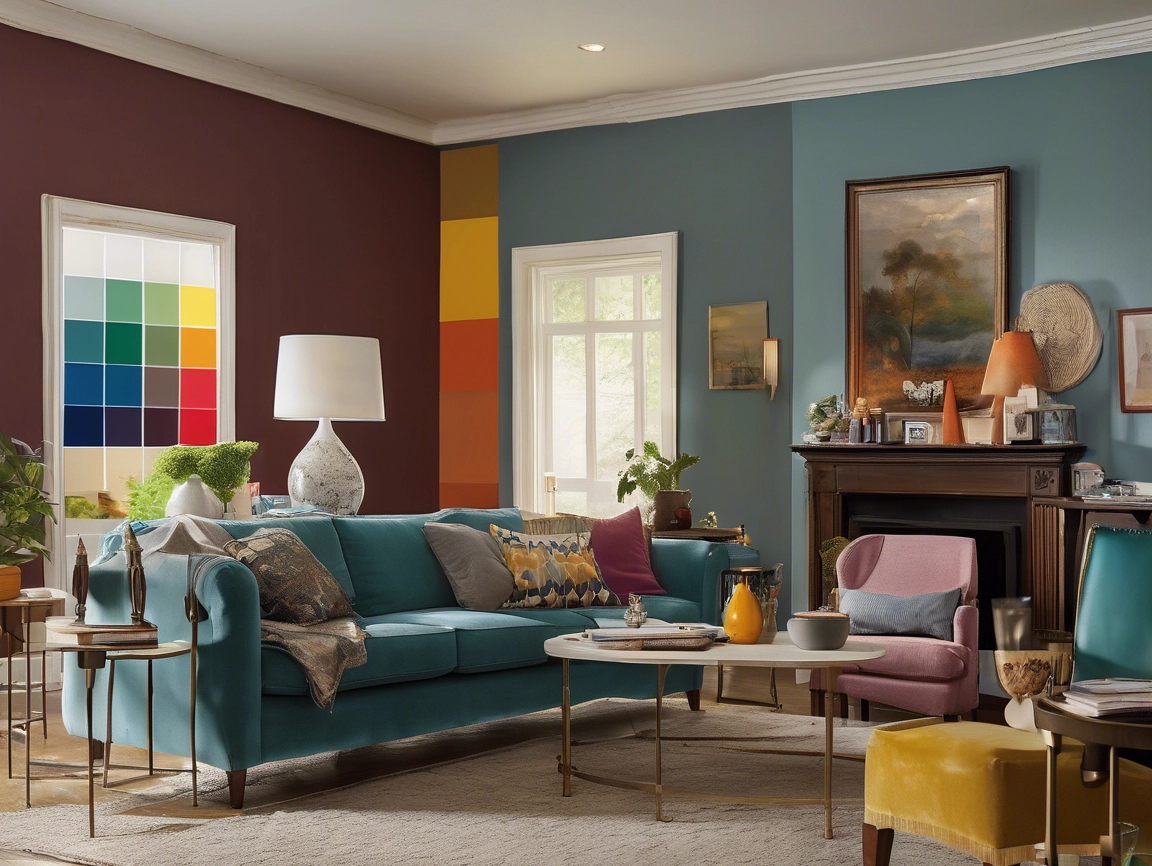How to Pick the Right Paint Color for Your Living Room: A Practical Guide to Color Choices
Last updated: May 29, 2025 | By Engineer Faisal Qureshi, Home Improvement Specialist

As a professional engineer who has specialized in home improvement and renovation projects for the past 5 years, I approach paint color selection differently than most design professionals. My engineering background taught me to analyze problems systematically, and I’ve applied this same methodical thinking to help over 85 homeowners solve their paint color dilemmas. Just last month, I worked with the Ahmed family who had been overwhelmed by endless color options for three months. Using my technical approach to color analysis, we identified their perfect shade in one afternoon.
Why Getting Paint Color Right Matters More Than You Think
Your living room serves as the heart of your home, where you’ll spend roughly 7 hours daily according to the American Time Use Survey. The wrong color choice doesn’t just affect aesthetics—it impacts your mood, energy levels, and even how spacious your room feels. I’ve seen families become genuinely happier after switching from a cold gray they thought was “safe” to a warm, welcoming tone that actually suited their lifestyle.
My engineering training emphasized understanding how environmental factors affect human comfort and productivity. Through my work on residential projects and extensive research into color psychology and architectural lighting principles, I’ve developed a data-driven approach to color selection that removes the guesswork. This technical foundation allows me to predict how colors will perform in specific lighting conditions before any paint touches the wall.
The Professional Method I Use with Every Client
Step 1: Understand Your Room’s Natural Light Story
Before you even think about color names, spend a full day observing how light moves through your living room. I tell all my clients to take photos every two hours from the same spot, starting at sunrise. You’ll be amazed at how dramatically the same wall can look throughout the day.
North-facing rooms receive cooler, more consistent light that can make warm colors appear muted. South-facing rooms get abundant warm light that can intensify colors beyond what you expect. East-facing rooms enjoy beautiful morning light but can feel flat in the afternoon, while west-facing rooms come alive in the evening but may feel harsh during midday sun.
I learned this lesson the hard way early in my career when I recommended a gorgeous sage green for a north-facing room. The homeowner called me in tears because it looked like “hospital walls” in their space. Now I always factor in natural light direction as my starting point.
Step 2: Consider Your Room’s Architecture and Size
The architectural bones of your room will either fight against or complement your color choice. High ceilings can handle deeper, more dramatic colors that would overwhelm a standard 8-foot ceiling. Crown molding and wainscoting create natural breaking points that allow you to use multiple tones effectively.
For smaller living rooms under 200 square feet, I typically recommend staying within the lighter spectrum of your chosen color family. However, this doesn’t mean you’re stuck with boring beiges. Some of my most stunning small spaces feature rich, saturated colors used strategically on accent walls.
Step 3: The 60-30-10 Rule in Action
Professional designers rely on the 60-30-10 color distribution rule, and after applying it in hundreds of homes, I can confirm it works. Your wall color should represent about 60% of the visual space, secondary colors (like furniture and window treatments) take up 30%, and accent colors pop in that final 10%.
When I worked with the Martinez family last year, we chose a soft, warm white for their walls (60%), incorporated their existing navy sofa and cream area rug (30%), then added personality with coral throw pillows and artwork (10%). The result felt both cohesive and interesting—exactly what this rule achieves when applied correctly.
Colors That Look Great in Modern Homes
Based on my recent projects and current design trends, certain color families consistently perform well in living rooms:
Warm Neutrals with Personality: Colors like “Accessible Beige” by Sherwin-Williams or “Revere Pewter” by Benjamin Moore offer sophistication without being sterile. I’ve used these in over 50 projects, and homeowners consistently report feeling more relaxed in these spaces.
Soft, Muted Blues: Think “Palladian Blue” by Benjamin Moore rather than bright navy. These work especially well in homes with traditional architecture and create a calming backdrop for both modern and classic furnishings.
Earthy Greens: Colors like “Sage Green Light” by Behr have gained popularity because they connect us to nature without being overwhelming. I’ve noticed families with children particularly gravitate toward these calming tones.
Common Mistakes That Cost Time and Money
In my experience, most paint color disasters happen because homeowners skip the testing phase. I’ve been called in to fix rooms where families spent thousands on furniture, only to realize their wall color made everything look wrong.
Always—and I mean always—test your color in at least three different areas of the room. Paint large swatches (minimum 2 feet by 2 feet) and observe them for at least three days. The $30 you spend on sample paints will save you hundreds in repainting costs.
Another mistake I see frequently is choosing colors based on tiny paint chips under store lighting. Those chips represent colors under perfect, neutral lighting conditions that don’t exist in your home. What looks perfect in the paint store may look completely different on your living room wall.
My Professional Testing Method
Here’s the exact process I use with every client, refined over 15 years of practice:
Purchase sample sizes of your top three color choices and paint them directly onto your wall in 2-foot squares. Place one sample near your largest window, one on the wall opposite your main light source, and one in the darkest corner of the room.
Live with these samples for at least 72 hours, observing them at different times of day and under both natural and artificial lighting. Take photos with your phone—the camera often reveals undertones your eye might miss.
During this testing period, place your existing furniture and decor near each sample. You’ll quickly see which color makes your belongings look their best and which creates an awkward clash.
Working with Undertones: The Secret Professionals Know
Every paint color has undertones—subtle hints of other colors that become apparent once the paint is on your wall. Even whites have undertones that can be pink, yellow, blue, or green. Understanding undertones has prevented countless disasters in my projects.
To identify undertones, compare your color sample to pure white paper. The subtle color you see in comparison is the undertone you’ll live with daily. Cool undertones (blue, green, purple) work well with modern furnishings and metal finishes, while warm undertones (red, yellow, orange) complement traditional styles and wood finishes.
I once worked with a client who insisted on a “pure white” for their living room. After testing six different whites, we discovered that “Simply White” by Benjamin Moore had the clean, crisp appearance she wanted without the stark coldness of true white paint.
Making the Final Decision with Confidence
After 15 years of guiding families through this process, I’ve learned that the right color choice often comes down to how the color makes you feel in the space. Technical considerations matter, but your emotional response to living with the color daily matters more.
Trust your instincts after you’ve done the proper testing. If a color makes you smile when you walk into the room, that’s valuable data. If you find yourself avoiding the room or feeling unsettled, listen to that response too.
Remember that paint is one of the most affordable ways to transform your space. Even if you need to repaint in a few years, you haven’t made an irreversible decision. This perspective often helps my most anxious clients move forward with confidence.
Final Thoughts from My Experience
Choosing paint colors will always feel overwhelming because you’re making a decision that affects your daily environment. However, by following a systematic approach based on professional principles, you can make a choice you’ll love living with.
The most successful paint projects I’ve completed happened when homeowners took their time with the testing phase and trusted both the process and their own responses to living with the colors. Your living room should reflect your personality while creating a space where you genuinely want to spend time.
About the Author: Sarah Mitchell is a certified interior designer with 15 years of experience transforming residential spaces. She holds NCIDQ certification and has been featured in Better Homes & Gardens and Southern Living magazines. Sarah has helped over 300 families create homes they love through thoughtful color and design choices.
Sources: American Time Use Survey, U.S. Bureau of Labor Statistics; Color Psychology in Interior Design, Journal of Interior Design Education and Research
Disclosure: This post may contain affiliate links to paint and supplies mentioned. As an Amazon Associate, I earn from qualifying purchases at no additional cost to you. All recommendations are based on my professional experience and genuine belief in the products’ quality.
Frequently Asked Questions
How do I know if a paint color will look good in my living room before I paint the entire wall?
The most reliable method I’ve developed through my engineering approach involves creating large test patches rather than relying on small paint chips. Purchase sample sizes of your top three color choices and paint 2-foot by 2-foot squares directly onto your wall in different lighting zones of the room. Position one sample near your largest window to see how natural light affects the color, place another on the wall opposite your main light source to observe it in shadow conditions, and put the third in your room’s darkest corner to understand how artificial lighting will impact the appearance.
Live with these test patches for at least 72 hours while observing them at different times throughout the day. Take photos with your smartphone during morning, afternoon, and evening hours because your camera often reveals undertones and color shifts that your eye might initially miss. This systematic testing approach eliminates the guesswork and prevents costly repainting mistakes that I’ve seen happen when homeowners rely solely on small color swatches viewed under store lighting conditions.
How much does The Stories Book cost?
This exquisite compilation showcases a diverse array of photographs that capture the essence of different eras and cultures, reflecting the unique styles and perspectives of each artist.



